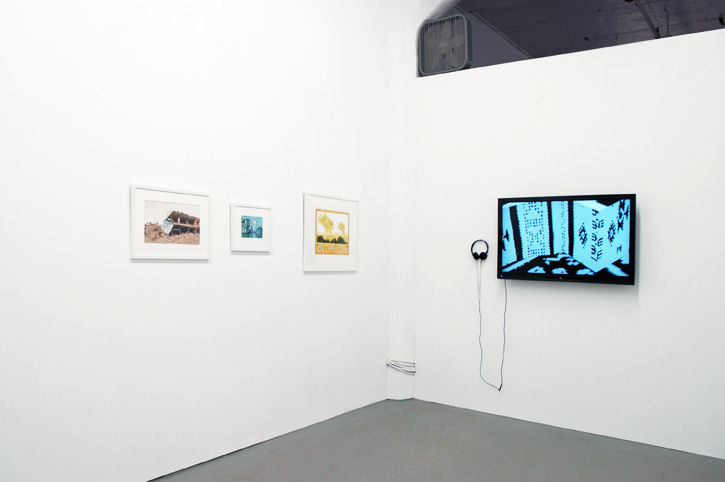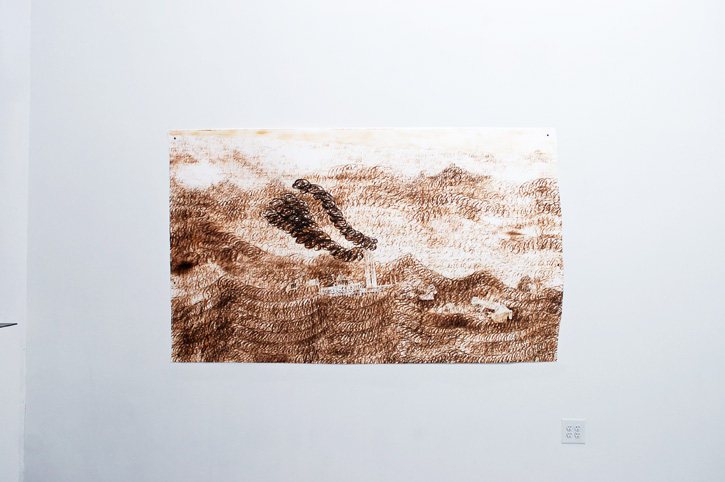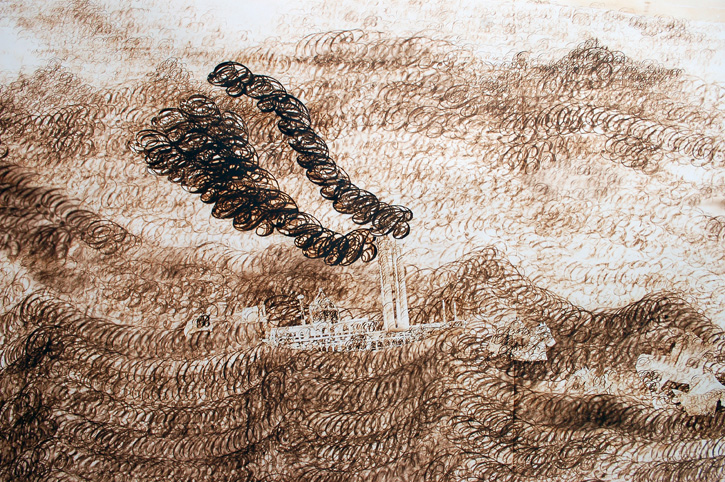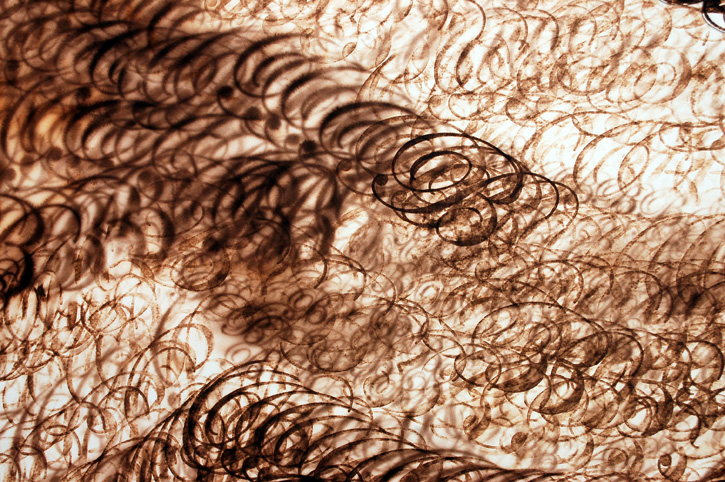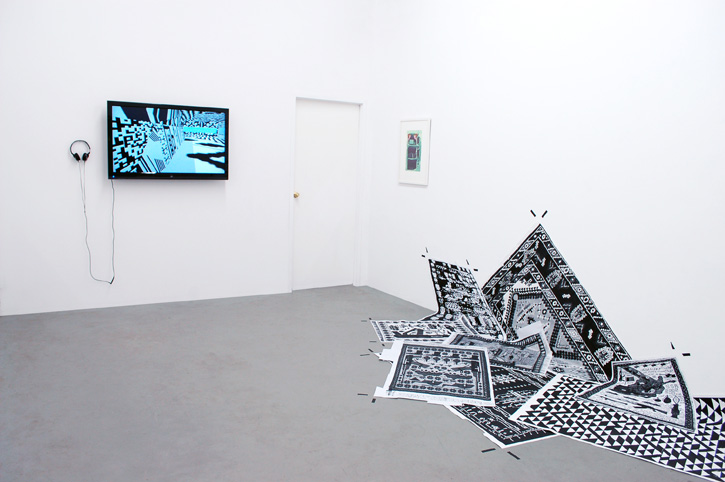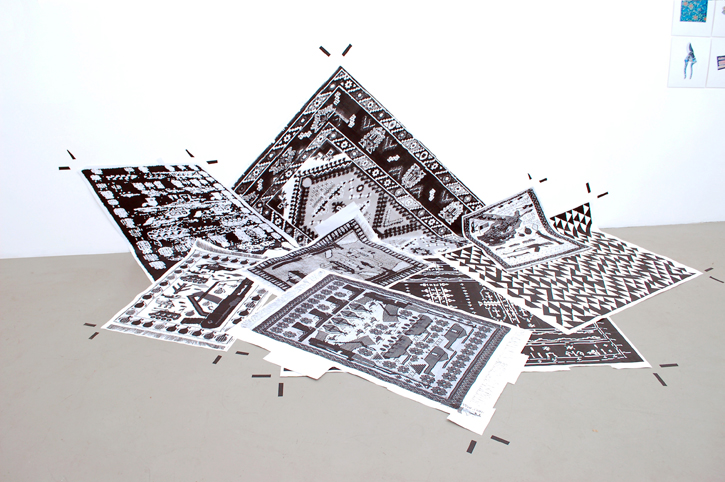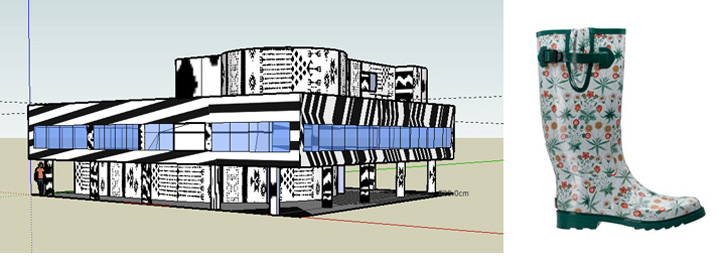Ornament and Crime
Ornament and Crime
Stephanie Syjuco, David Mabb, Susanne Slavick, and Stacy Lynn Waddell
Curated by Lauren Frances Adams
November 2 – December 15, 2013
1717 Troutman #327, Queens, NY
Opening Reception:
Saturday, November 2, 7 – 10 pm
“For beauty is nothing but the beginning of terror. . .” Rainer Marie Rilke
Ortega y Gasset Projects is pleased to present Ornament and Crime, an exhibition organized by Lauren F. Adams comprised of artworks by Stephanie Syjuco, David Mabb, Stacy Lynn Waddell, and Susanne Slavick. The exhibition contends with the Adolf Loos essay from 1913 of the same name—a provocative and supremacist philosophy of how ornament and decoration impairs modern society, not only through wasted labor but also by embodying that which is degenerate or unsophisticated. Unlike Loos, the artists included in this exhibition engage ornament not as mere style or form, but as a platform to debate the political and societal concerns of our time.
Together, the works in this exhibition are actively defying what Loos described as the greatness of the modern age, “freedom from ornament.” Instead, these works seek to illuminate the weight of history, resuscitating or borrowing archival patterns in an effort to elucidate contemporary notions about political order, social hierarchies, and constructed authenticity. Existing between homage and critique, the artworks in the exhibition utilize ornament as a sort of Trojan horse — acting as subversive cover to reveal disruptive or terrible truths.
Installations by Stephanie Syjuco of various ‘ethnic’ and ‘tribal’ patterns question the very categories that we assign to regional patterns in the amnesiac globalized marketplace. Syjuco achieves this through appropriation, such as in the Dazzle Camouflage Propositions, which pictures Le Corbusier’s Villa Savoye in France, covered with Vietnamese and Algerian patterns. The result is the contrasting of iconic modernist architecture with decorative languages that are native to countries colonized by France, and eventually emancipated through brutal wars. Syjuco’s interventions are simple juxtapositions that reveal contested histories — a visual contradiction resulting in an uneasy reconciliation.
The paintings of Susanne Slavick feature photographs found online (and altered) of the physical devastation of recent wars in the Middle East. She combines these with decorative painted embellishments derived from the art and architecture of the sites and cultures pictured. Layering contemporary imagery of rubble and ruin with ornamental details from historical sources, works such as Restore: Sarafiya Star over the Tigris are intended to reveal physical and cultural loss and to recuperate through aesthetic means. As Slavick notes, “The presence of this ornate detail insists that the targets of war are neither faceless enemies nor sites devoid of culture. They are not just anywhere but somewhere, not just anyone but someone.” In this regard, Slavick’s works counter Loos’ insistence that the forward progress of modernity requires selective eradication of the nuance of lived human experience, exhibited through the embellishment of everyday forms.
Stacy Lynn Waddell burns, singes, stains and gilds the surfaces of walls and paper in an effort to recontextualize historical narratives and classical representation. Repetitive acts of destruction create new surfaces of subversive beauty and visual conflict. Concerned with African American cultural history, iconographic images such as the works of the Hudson River School, and the labor and trace of the artist’s hand, Waddell’s artworks utilize personal symbolism in search of the universal patterns which unite us.
David Mabb presents Highlights from the Morris Kitsch Archive, a selection from a collection that contains over 500 images, largely drawn from the Internet, of commercial objects decorated with 19th century William Morris patterns. Isolating aesthetic history as a commodity, Mabb’s archive clarifies the tension between Morris’ utopian ideals of fine craft and pre-industrial labor roles and capitalism’s post-industrial consumption endgame. In Mabb’s words, the trace of Morris in the 21st century “has acted as a form of iconoclasm, undermining the integrity of Morris’s design and production, obscuring their utopian and therefore critical potential; it leaves no evidence of Morris’s politics, whilst appearing to celebrate him.”
BIOS
Stephanie Syjuco creates large-scale spectacles of collected cultural objects, cumulative archives, and temporary vending installations, often with an active public component that invites viewers to directly participate as producers or distributors. This has included starting a global collaborative project with crochet crafters to counterfeit high-end consumer goods; presenting a parasitic art counterfeiting event, “COPYSTAND: An Autonomous Manufacturing Zone” for Frieze Projects, London (2009); and “Shadowshop,” an alternative vending outlet embedded at SFMOMA (2010-11). Born in the Philippines, she received her MFA from Stanford University and BFA from the San Francisco Art Institute. Her work has been included in exhibitions at MoMA/P.S.1, the Whitney Museum of American Art, SFMOMA, ZKM Center for Art and Technology, Germany; Z33 Space for Contemporary Art, Belgium; UniversalStudios Gallery Beijing; and The Contemporary Arts Museum Houston, among others. She will be joining the faculty at the University of California at Berkeley in January 2014 as an Assistant Professor in Sculpture. She is the recipient of the Joan Mitchell Painters and Sculptors Award.
Susanne Slavick is the Andrew W. Mellon Professor of Art at Carnegie Mellon University and recent editor and curator of Out of Rubble (Charta, 2011), a book and traveling exhibit featuring international artists who respond to the aftermath of war. She has exhibited internationally, with recent solo shows at the Chicago Cultural Center, McDonough Museum in Youngstown, and Accola Griefen Gallery in NYC, where she is represented. Slavick studied at Yale University, Jagiellonian University in Krakow, Temple University Abroad in Rome and Tyler School of Art in Philadelphia. She has published visual essays and articles for: Cultural Heritage and Arts Review, Cultural Politics (Duke University Press) Frontiers: A Journal of Women’s Studies (University of Nebraska Press), Guernica: A Magazine of Art & Politics, and AlterNet. In January 2014, she will present a solo exhibition at Princeton University’s Bernstein Gallery.
Since earning her MFA from The University of North Carolina at Chapel Hill in 2007, Stacy Lynn Waddell’s work has been recognized and exhibited nationally. Waddell has participated in exhibitions at the Franklin Humanities Institute at Duke University in Durham, NC, the Weatherspoon Art Museum in Greensboro, NC, The North Carolina Museum of Art in Raleigh, NC, The Pennsylvania Academy of the Fine Arts, Philadelphia, PA, Project Row Houses in Houston, TX, The Studio Museum in Harlem in NY and On Stellar Rays in NY among other venues. Her work is included in several public and private collections that include The Nasher Museum of Art, Durham, NC, the Weatherspoon Art Museum, Greensboro, NC, The North Carolina Museum of Art, Raleigh, NC, The Gibbes Museum of Art, Charleston, SC and The Studio Museum in Harlem, New York, NY. Waddell is a 2010 recipient of the Joan Mitchell Foundation Painters and Sculptors Grant. She currently resides in Chapel Hill, NC.
David Mabb is an artist who works with the textile and wallpaper designs of nineteenth century interior designer, writer and socialist William Morris. Mabb’s interest in Morris stems from the social and political implications of his work, the continued relevance of his politics and the continuing market for his designs. Mabb’s interpretations or reconfigurations of Morris’s designs have foregrounded the relationship between Morris’s own utopian thinking and other forms of modernist cultural production. David Mabb is a Reader in Art at Goldsmiths, University of London. His work has been exhibited in numerous international exhibitions including Leo Kamen Gallery (Toronto), William Morris Gallery (London), Tate Britain (London), and Nature Morte (Berlin), among others.
Lauren Frances Adams (Snow Hill, North Carolina, b. 1979) lives and works in Baltimore, Maryland, where she is a full-time faculty member at the Maryland Institute College of Art. She has had recent solo exhibitions at Back Lane West, Cornwall, UK; Contemporary Art Museum St. Louis (Front Room and EXPO Chicago); and Conner Contemporary, Washington, D.C. Her work has been featured in group exhibitions including: Nymans House and Gardens, Sussex, UK; Southeastern Center for Contemporary Art, North Carolina; CUE Foundation, New York; Mattress Factory and the Andy Warhol Museum of Art, Pittsburgh, PA; among many others. She is a Joan Mitchell Foundation MFA Grant recipient (2007), and attended the Skowhegan School of Painting and Sculpture (2009).


